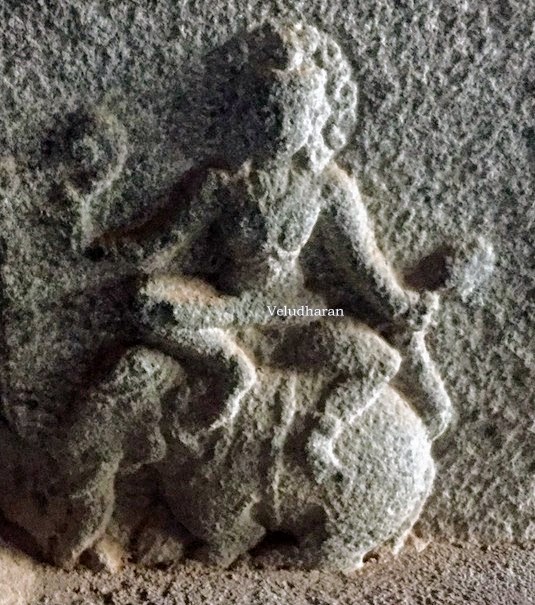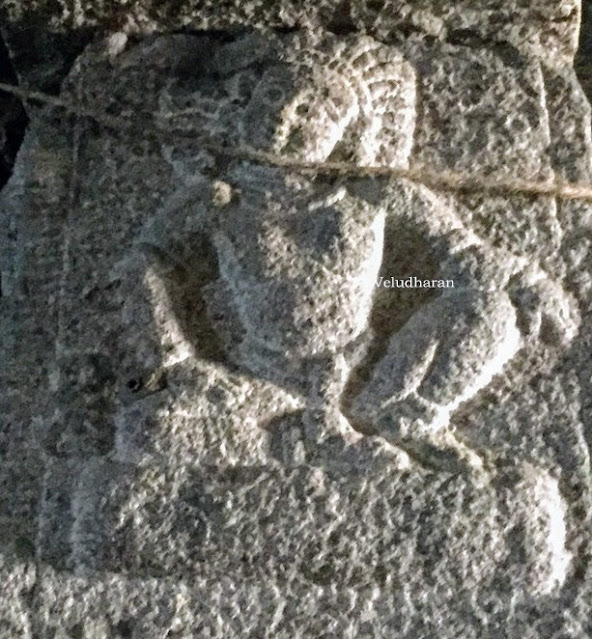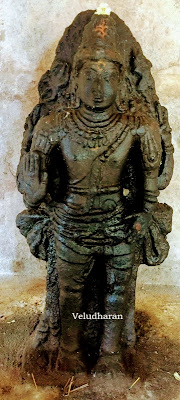This second visit to the Sri
Jambunatheswarar Temple at Jambai was a part of the Viluppuram Heritage Walk
organized by History Trails, on 24th and 25th
July 2021. The First visit to this temple was a part of the Thiruvannamalai
Heritage visit organized by the Tiruvannamalai District Historical Research
Center on 30th December 2018. Jambai is a 1000-plus-year-old
ancient village. Saivam, Vainavam, Jainism, Buddhism, and Saktham flourished in this village. The temples like Shiva Temple, Ayyanar Temples,
Jain sculptures, and Sangam period (1st Century BCE)
inscriptions on the rocks prove that Jambai is an ancient Village. This place, Jambai, was called Sambai, “Veerarajendra
Chozhapuram,” and “Valaiyur” during the Chozha period.
Moolavar : Sri Jambunatheswarar, Sri
Jambukeswarar, Sri ThanthondreeswararConsort : Sri Akilandeswari.
Some of the Salient features of this temple are….The temple is under renovation, some of the Murtis / Idols are
removed and kept outside the sanctum, and the details of the sannidhis may not
hold good after Kumbhabhishekam.
The temple faces east with balipeedam, Dwajasthambam, and Rishabam with a two-tier Rajagopuram. The temple is on the northern banks of the river Thenpennai.
In koshtam, Vinayagar (not in the niche now) with
Venkotrakudai and Samaram, Dakshinamurthy, Lingothbavar, Brahma, and Durgai. In
the praharam, sannidhi for Vinayagar, Maha Vishnu with Sridevi and
Bhoodevi, A Shiva Linga with Nandi, Subramaniar with Valli Devasena, Bairavar,
Thavvai (Jyeshta Devi with Manthan and Mandhi), Lakuleesar in standing
posture, Navagrahas, Mahishasuramardini (in the front Mandapam), and Chandikeswarar.
Dwarapalakas look cute like Pallava sculptures. Ambal is in a separate
Temple facing east.
There are two Navakanda statues kept abutting the main
Sanctorum mukha mandapam.
ARCHITECTUREThe temple consists of a sanctum sanctorum, antarala, ardha
mandapam (originally this was a sanctum sanctorum), maha mandapam, and a mukha mandapam. In the sanctum, moolavar is on a
round avudayar. The two-tier nagara vimanam is over the sanctum without any
stucco images. The adhisthanam is of prati bandha (virutha/round kumudam)
adisthanam. The walls are supported with square/Brahma kantha pilasters.
The mukha mandapam of the main shrine has a simha pillar, and the Ambal sannidhi mandapa pillars are yazhi pillars. Some experts believe that this Simha pillar belongs to the Pallava period.
Pallava pillars (9th to 10th century)
Donors at the entranceDonors at the entranceAmbal Temple
Dancer's relief stone used on the floor
HISTORY AND INSCRIPTIONSSome experts claim that the original temple belongs
to the Pallava period and was reconstructed as a stone temple during the Chola period. The
temple has contributions from the Rashtrakutas during the middle of the 10th century.
Murugan, Jyeshta Devi, Kalabairavar, and Durgai are believed to be Rashtrakutas sculptures. The temple also has the contributions of Medieval Chozhas, Pandyas, Rashtrakutas, Vijayanagaras, and Nayaks.
The inscriptions recorded from this temple belong to Parantaka-I,
Rajararaja, Rajendran-I, Vikrama Chozha, Kulothunga Chozha-I, Rajadhirajan, Vijayarajendran (Rajadhiraja-I ..? ), Pandya Kings Sundara Pandyan, Kulasekara Pandyan, Pallava kings Koperunjingan, Rashtrakuta King Kannaradevan (Krishna-III), Vijayanagara kings, Sadasiva Maharaya, Achyutadeva Maharaya, Virapratapa Virupakshadeva Maharaya-II, and Vira Narasingaraya.
The inscriptions mainly speak
about donations made to the temple in terms of villages, money, coins, Gold
coins, lands for conducting regular poojas, Naivedyam, and burning of perpetual lamps with the donor’s name. The inscriptions also mention Lord Shiva as “Thanthondreeswarar” and “Thanthondripiran”; then, how this name was changed to the present name of
Jambukeswarar is not known. This place was called “Sambai”, alias “Veerarajendra
Chozhapuram”, also called “Valaiyur”, alias Nottavodapuram in Vanagopadi, alias Madurantaka Valanadu, a part of Jayangonda Chozha mandalam. (Exemption of Tax - Somasulavari to this temple during the Achyutadeva Maharaya period)
Parantaka-I ‘s inscription records the endowment of worship
to the Jyeshta Devi for which a land was gifted. The Jyeshta Devi,
presently in the praharam, was on the
banks of the Temple Tank during the Parantaka Chozha period.
Parantaka Chozha-I’s 34th reign year inscription
records the endowment of the construction of
a Mandapa, Maintenance, and burning of a
perpetual lamp by Viranaraniyar, consort of Gandaradita and daughter-in-law of
Chozhamadeviyar, in the name of “Nagarattar valaiyur”. For the same 70 kalanju, Gold was gifted.
Parantaka-I’s inscription records the sacred bath on Sankranti days of Tanthondriappar at Valaiyur. Similarly, a fragment
inscription records the endowment of burning a perpetual lamp in front of
Vidividangar (processional deity) by Ayyaradigal, a headman of Irayankudi. Another inscription records the endowment of
burning 5 perpetual lamps for which 50 Kalanju Gold was gifted. Rajaraja-I’s
28th reign year inscription starts with his meikeerthi and records a
gift of 10 Kalanju of gold deposited with the urar / villagers sabha of Palaippandal
on the southern bank, for a perpetual lamp in the temple by a merchant of the
village by name Angadi Porraman for (the memory of) one piratti Siralan of
Munaippadi Navalur. The reason for the gift is stated to be that the latter
trespassed into the former’s house in the night and tried to assault his
mistress in his very presence, by which he was enraged so much as to stab the intruder to death.
Rajaraja-I’s 24th-year inscription records the
grant of 20 Servu lands by the Sabha of
Nerkunram alias Vairamegha Chaturvedimangalam, urar to the user of Kolliyur in
exchange for lands acquired, on their behalf, from the latter by the Rajaraja Vanakovaraiyar for the
construction of a tank called “araiyagal–adittapereri” in their Village. The amount of taxes to be given to the King by
the Urar was fixed as 1000 kalanju Gold.
Kulothunga Chozha's (III) 3rd reign year inscription records the gift of 64 sheep (..?) for burning two perpetual lamps. One Pallicheriyadiyan Nambiyan alias Kovalarayaperaraiyan happened to wound fatally accidentally another man Pennai Vadakarai Chengundra Nattu Valaivetti, Velalan Pon PaRRiyudayan Kundran Seerudayan, and the people of 19 Nattu Chitramezhi Nattars met, threw the blame on him, and ordered to endow 64 Sheep (Saava Moova Peradus/ ewes) for burning two lamps (67 / 1906).
Vikrama Chozha's period inscription records the endowment of burning a lamp for the reason being... A man apparently pushed his wife, as a result of which she fell and died. The 1500 men of the four quarters declared him guilty in their assembly and compelled him to provide for lamps.
Vikrama Chozha's 9th reign inscription records the gift of 64 Cows for two lamps, by a man who, in the course of a comparison of martial skill with two vellalas, killed one of them.
The Chozha King Rajakesarivarman alias Udaiyar Sri Virarajendradeva (1063- 1070 CE), an inscription records the gift of 500 Kulis Land to the account of Rajendrapura by the temple authorities to the temple account, among whom figures the Mahavratin Lakulisvara Pandita as the head of the pujaris. This Pujari name figures in the Melpadi inscription, of Rajendra Chozha-I (SII Vol -III, page 28) and Beligami inscriptions 9 Epic Indica Vol -V p 227), perhaps all these were the same. Lakulisvara Pandita was evidently a Kalamukha. (A Lakulisvara's idol is in the praharam) Vanakovarayan Rajarajadevan Vannenjarayan’s 11th
reign year inscription records that Kasayam, Ponvari, Alamji, and Antarayam tax exemption was given to the Village Gunamangalam, which belongs to this
“Tiruttantonri Avudaya Nayanar”.
There are 5 Pandya Kings' inscriptions recorded from this temple. They belong to Kulasekara Pandya (3), Maravarman Vikrama Pandyan, and Sadayavarman Sundara Pandyan. Kulasekara Pandya's inscription records the taxes to be paid depending on the crops raised. like, Nanjai, Beetle Nut leaves, Ginger, Turmeric, Samai, El, Kol, Alasanthi Payiru, etc.
The Kulasekara Pandya's 33rd reign year inscription records that due to a shortage of funds, amounts to 31 Panam for conducting Thiruvizha and maintenance, so the trustees gave lands belonging to the temple as Kani to Thirukotti Alwan Periyan Eeswara Battan, who belongs to Manalur. Another Vanakovarayan Rajarajadevan Vannenjarayan’s 11th
reign year inscription records that agreements were made by the Siva Brahmins to
provide paddy offerings to gods on two festival days and also feeding for Maheswaras with the offered food from the interest of 60
kalam paddy measured on the “Tonro Marakkal”, received from Arasan Tiruttonda
Nambi, a Devakanmi, belongs to the temple Udayar Thiruvannamalai Udaya Nayanar (Lord Shiva of Thiruvannamalai).
Koperunjingan’s
13th reign year (119 of 1906) inscription records that a tax-free land of 150 Kuli by the
Thanathar for this temple, according to the order of Gangayan, a small region leader to Annamalai, the
younger brother of Atkondan, who cut off his head so that the nirutha mandapa ( நிருத்த மண்டபம் ) in
the temple of Tirttantonri Aludaiya Nayanar at Sambai might be completed.
Atkondan is stated to be the younger brother of Porralvi, Thevaradiyal (temple
maidservant) residing in the Village. (This inscription is for an instance of
Voluntary sacrifice for the successful completion of a Mandapa.) A land measuring 150 Kuzhi was gifted to Annamalai. (119 / 1906 - SII Vol XII-178).
Koperunjingan’s 14th reign year inscription
records the endowment of offerings to the God Thanthondri Aludaya Nayanar, on
the 7th day of the annual festival, by Mulaiyanudaiyan Ponparappinan
Kovalrayan, for which 10 Kalam paddy was received by the trustees (thanaththar) of this temple.
Koperunjingan’s 16th reign year inscription
records the endowment of a special pooja called “Vennenjan Thirunal”, in the
month Purattasi (August – September), from the income of the paddy assigned by
Vannenja Nayanar, which is the chief of Vanakovarayan Rajadevan Vannenjan of
Aragalur, a subordinate to Koperunjingadeva.
Rajendran-II's 3rd reign year inscription records that a lady Veerabhudra's mother Sendhan Umayal was compelled to pay the Taxes by the Village official Malaiyaman Katti Meloorudayan Pazhanguran Kundran. When she was unable to pay, he told her that he would report to the King. Due to this, she consumed poison and committed suicide. On verification by the "Nangu Thisai Pathinenbhoomi NanadesikaL", the Village officer was found guilty and, as a punishment, he was ordered to burn a
perpetual lamp at this temple, for which 32 kasu was received from the Village official. It was agreed that 2 parts of the required oil would be supplied by the Manigrama Villagers and one part by the Sankarapadi Villagers. (80 / 1906)
Ref: 1. South Indian Inscriptions, Volume-XII.2. Annual Report on South Indian Epigraphy, Year 1906.
Maha Kumbhabhishekam was conducted on 2nd February 2025. Inscriptions
LEGENDSDevotees worship Lord Shiva and Ambal for the Child boon, to get rid of Rahu & Ketu Dosham to remove marriage obstacles.
POOJAS AND CELEBRATIONSApart from regular poojas, special poojas are conducted on
Pradosham, Amavasya, Thai Pongal, Maha Shivaratri, and Karthigai Deepam.
TEMPLE TIMINGS:Since the temple is under renovation, the time of opening and
closing is unpredictable.
CONTACT DETAILS:Venkatesan 9443815936, Shanmugam +91 9965206975, and Elumalai
+91 9597140997 may be contacted for further details.
HOW TO REACH:Jambai is about 19 km from Thirukovilur and 25 km from
Thiruvannamalai.The nearest Railway Station is Thirukovilur.
LOCATION OF THE TEMPLE: CLICK HERE
Vinayagar and Lakulisar ( Lakulisar was identified as Bhairavar, and this was also brought from Melai Chalukya as a Victory trophy )
Dancers' relief stone slab used on the floor
Mahisasuramardini ( brought as a victory trophy from Melai / Kalyani Chalukyas by Rajendra Chozha's first son )Thavvai /தவ்வை/ Jyeshta Devi - 9th to 10th Century ( Parantaka Chozha period inscription records the endowment of burning 2 perpetual lamps )--- OM SHIVAYA NAMA ---
Pallava pillars (9th to 10th century)
Donors at the entrance
Donors at the entrance
Ambal Temple
Dancer's relief stone used on the floor
Vinayagar and Lakulisar ( Lakulisar was identified as Bhairavar, and this was also brought from Melai Chalukya as a Victory trophy )
Dancers' relief stone slab used on the floor
Mahisasuramardini ( brought as a victory trophy from Melai / Kalyani Chalukyas by Rajendra Chozha's first son )
Thavvai /தவ்வை/ Jyeshta Devi - 9th to 10th Century ( Parantaka Chozha period inscription records the endowment of burning 2 perpetual lamps )






























Today 2nd February, 2025, Maha kumbabisekam conducted with grand celebrations.
ReplyDeleteThanks a lot for the information and will correct the post..
Delete